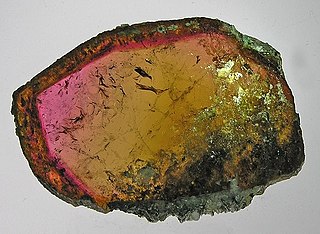
Tourmaline is a crystalline silicate mineral group in which boron is compounded with elements such as aluminium, iron, magnesium, sodium, lithium, or potassium. This gemstone comes in a wide variety of colors.

Feldspar is a group of rock-forming aluminium tectosilicate minerals, also containing other cations such as sodium, calcium, potassium, or barium. The most common members of the feldspar group are the plagioclase (sodium-calcium) feldspars and the alkali (potassium-sodium) feldspars. Feldspars make up about 60% of the Earth's crust, and 41% of the Earth's continental crust by weight.
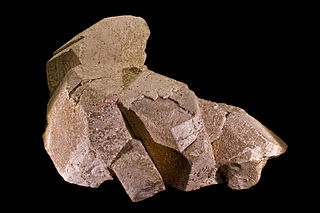
Orthoclase, or orthoclase feldspar (endmember formula KAlSi3O8), is an important tectosilicate mineral which forms igneous rock. The name is from the Ancient Greek for "straight fracture", because its two cleavage planes are at right angles to each other. It is a type of potassium feldspar, also known as K-feldspar. The gem known as moonstone (see below) is largely composed of orthoclase.

Microcline (KAlSi3O8) is an important igneous rock-forming tectosilicate mineral. It is a potassium-rich alkali feldspar. Microcline typically contains minor amounts of sodium. It is common in granite and pegmatites. Microcline forms during slow cooling of orthoclase; it is more stable at lower temperatures than orthoclase. Sanidine is a polymorph of alkali feldspar stable at yet higher temperature. Microcline may be clear, white, pale-yellow, brick-red, or green; it is generally characterized by cross-hatch twinning that forms as a result of the transformation of monoclinic orthoclase into triclinic microcline.

Abernathyite is a mineral with formula K(UO2)(AsO4)·3H2O. The mineral is named after Jesse Evrett Abernathy (1913–1963) who first noted it in 1953 in the U.S. State of Utah. It was described as a new mineral species in 1956. Abernathyite is yellow and occurs as small crystals.

Demesmaekerite is a rare uranium selenite mineral with the chemical formula: Pb2Cu5(UO2)2(SeO3)6(OH)6·2H2O.

Huemulite is a mineral with formula Na4Mg(V10O28)·24H2O that is yellow to orange in color. It was first discovered in Argentina in 1959 and described in 1966. The mineral is named for the Huemul mine in which it was discovered.
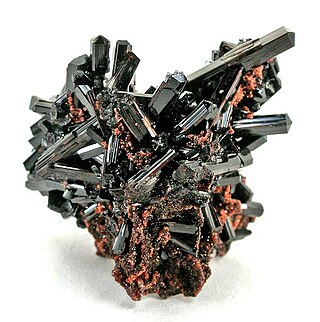
Manganvesuvianite is a rare mineral with formula Ca19Mn3+(Al,Mn3+,Fe3+)10(Mg,Mn2+)2(Si2O7)4(SiO4)10O(OH)9. The mineral is red to nearly black in color. Discovered in South Africa and described in 2002, it was so named for the prevalence of manganese in its composition and its relation to vesuvianite.
Eveslogite is a complex inosilicate mineral with a chemical formula (Ca,K,Na,Sr,Ba)
48[(Ti,Nb,Fe,Mn)
12(OH)
12Si
48O
144](F,OH,Cl)
14 found on Mt. Eveslogchorr in Khibiny Mountains, on the Kola peninsula, Russia. It was named after the place it was found. This silicate mineral occurs as an anchimonomineral veinlet that cross-cuts poikilitic nepheline syenite. This mineral appears to resemble yuksporite, as it forms similar placated fine fibrous of approximately 0.05 to 0.005mm that aggregates outwardly. The color of eveslogite is yellow or rather light brown. In addition, it is a semitransparent mineral that has a white streak and a vitreous luster. Its crystal system is monoclinic and possesses a hardness (Mohs) of 5. This newly discovered mineral belongs to the astrophyllite group of minerals and contains structures that are composed of titanosilicate layers. Limited information about this mineral exists due to the few research studies carried out since its recent discovery.

Kosnarite is an alkali zirconium phosphate mineral (KZr2(PO4)3) named after an expert of pegmatites Richard A. Kosnar. Kosnarite contains potassium, oxygen, phosphorus, and zirconium with sodium, rubidium, hafnium, manganese and fluorine (Na, Rb, Hf, Mn, and F) being common impurities found in kosnarite. It was discovered in nature for the first time in 1991 by Vandall T. King. Samples that were found in granitic pegmatites from the Mount Mica Quarry, Paris, Oxford County, Maine, US were sent to Eugene E. Foord for study. This became the first recorded case of naturally occurring kosnarite.

Canasite is a mineral whose name is derived from its chemical composition of calcium (Ca), sodium (Na), and silicon (Si). It was approved in 1959 by IMA.

Ganophyllite is a phyllosilicate mineral. It was named by Axel Hamberg in 1890 from the Greek words for leaf (φύλλον) and luster (γανωμα); the latter one was chosen due to the lustrous cleavages. The mineral was approved by the IMA in 1959, and it is a grandfathered mineral, meaning its name is still believed to refer to an existing species until this day. Tamaite is the calcium analogue, while eggletonite is the natrium analogue of said mineral.
Hendricksite is a member of the trioctahedral micas group. The mineral was named by Clifford Frondel and Jun Ito in honor of Sterling Brown Hendricks, who studied micas. It was approved in 1966 by the IMA.
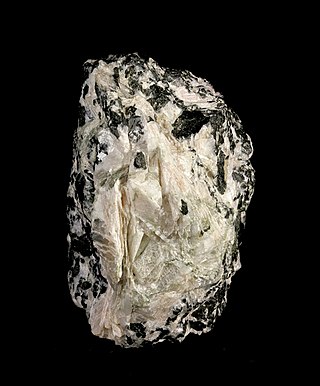
Baratovite is a very rare cyclosilicate mineral named after Rauf Baratovich Baratov from Tajikistan. It was discovered in 1974 at Dara-Pioz glacier, Tajikistan, and was approved by the International Mineralogical Association only a year later in 1975. The glacier gives home to 133 valid species, and is the type locality of 33 minerals, one of which is baratovite.
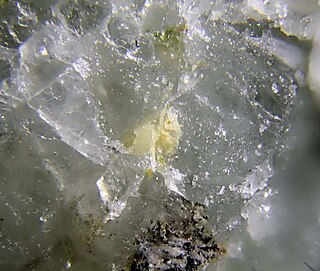
Katayamalite is a cyclosilicate mineral that was named in honor of mineralogist and professor Nobuo Katayama. It was approved in 1982 by the International Mineralogical Association, and was first published a year later.
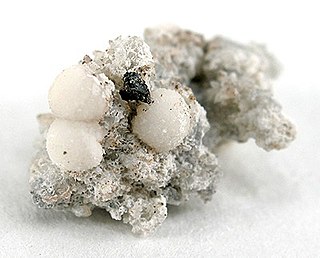
Dresserite is a mineral of the dresserite group, named in honor of John Alexander Dresser, geologist. It was approved by the IMA in 1968, but only a year after was it published. The rare mineral can only be found in Francon quarry, Canada. The quarry is located in the middle of the city of Montréal, but had been closed in 1981 and will not reopen in the future.

Yingjiangite is a mineral named after its type locality in the Yingjiang county in 1990. It is a member of the phosphuranylite group, although the species was doubted by two geologists. It is easily confused with phosphuranylite, though the two geologists claim that the mineral might be identical to it, even though yingjiangite was approved in 1989-1990 by the IMA.

Bannisterite is a mineral named in honor of mineralogist and x-ray crystallographer Dr. Frederick Allen Bannister (1901-1970). It is a calcium-dominant member of the ganophyllite group, and was previously identified as ganophyllite in 1936, but otherwise it is structurally related to the stilpnomelane group. It was approved by the IMA in 1967.
Falcondoite, a member of the sepiolite group, was first discovered in the Dominican Republic, near the town of Bonao. The mineral was found in a deposit mined by Falconbridge Dominica, and so was named "falcondoite" after the company. Falcondoite is frequently associated with sepiolite, garnierite, talc, and serpentine, and is commonly nickel-bearing. While the chemical formula for falcondoite can vary, the mineral must contain more nickel than magnesium to be considered its own species. The ideal chemical formula for falcondoite is (Ni,Mg)4Si6O15(OH)2·6H2O.
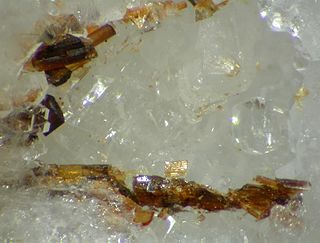
Vigezzite is a variant of the mineral aeschynite containing calcium, cerium, niobium, tantalum, and titanium. It was first discovered near Orcesco, Valle Vigezzo, Provo Novara, Northern Italy, in cavities of an albitic rock. The crystals of Vigezzite are flat prismatic crystals up to 2-3 mm length of an orange-yellow color.The name Vigezzite was chosen to draw attention to the locality that has produced the first occurrence of a Ca-Nb-Ta-mineral with Nb dominance over Ta, crystallizing with the aeschynite structure. The ideal chemical formula for vigezzite is (Ca,Ce),(Nb,Ta,Ti)2O6

















